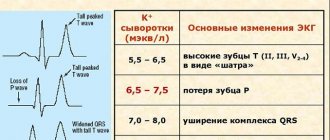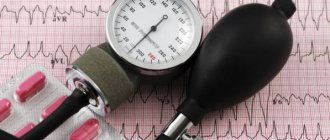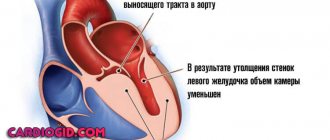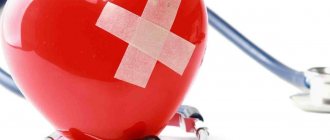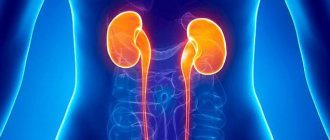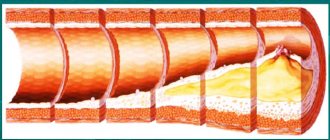Irina Baranova
Cardiologist
Higher education:
Cardiologist
Kuban State Medical University (KubSMU, KubSMA, KubSMI) Level of education - Specialist 1993-1999
Additional education:
“Cardiology”, “Course on magnetic resonance imaging of the cardiovascular system”,
Research Institute of Cardiology named after. A.L. Myasnikova
"Course on functional diagnostics"
NTsSSKh them. A. N. Bakuleva
"Course in Clinical Pharmacology"
Russian Medical Academy of Postgraduate Education
"Emergency Cardiology"
Cantonal Hospital of Geneva, Geneva (Switzerland)
"Therapy course"
Russian State Medical Institute of Roszdrav
Contacts
A persistent decrease in blood pressure is not as common as hypertension. Nevertheless, it occurs quite often. Sometimes the pressure decreases after a normal meal, causing severe weakness and dizziness. In the 70s of the last century, this condition was given the status of an independent disease, which was called postprandial hypotension. It is usually diagnosed in older people, more often in hypotensive patients and diabetics.
Cause of the disease
The causes of postprandial hypotension are not well understood. Only the conditions conducive to its development have been identified. After eating, blood pressure readings can significantly decrease in completely healthy people and even in hypertensive people. Food entering the intestines requires more blood to be digested. The heart responds to the “demands” of the digestive tract quickly; normally, the peripheral blood vessels are compressed - blood pressure is maintained within acceptable limits. Over the years, the heartbeat “lags behind” the signals from the gastrointestinal tract, vascular tone decreases, and it becomes more and more difficult for the body to maintain pressure at the proper level.
The main factors provoking the appearance of pathology
| Factor | Prerequisites for the development of the disease |
| Age over 65 | Changes in the structure of body tissues (nerves, blood vessels, heart, among others) sometimes lead to functional disorders, in particular, to disruptions in the transmission and propagation of nerve impulses. In this case, the blood is directed not to the digestive system, but to the area of the lower extremities |
| Endocrine disorders (diabetes mellitus) | Malfunctions of the endocrine system affect the activity of the central nervous system |
| Organic brain lesions | Negative changes contribute to the development of serious pathologies (Parkinson's disease, senile dementia of the Alzheimer's type) |
| Mental disorders | Mental disorders cause specific conditions (neurosis, psychopathy, neurasthenic disorders) |
| Hemodialysis | The procedure causes specific reactions in patients with certain kidney pathologies |
The mechanism of development of any form of hypotension is always due to a decrease in:
- cardiac output;
- peripheral vascular resistance;
- volumes of blood circulating in the body;
- tone of the coronary veins.
Postprandial hypotension is most severe during blood loss, anaphylactic shock, and sepsis. Situations like these require emergency medical attention.
Drinking alcohol increases the likelihood of developing hypotension. Alcohol causes blood vessels to dilate and urinate, causing dehydration and lowering blood pressure.
Consequences and complications of hypotension
Often, rare cases of hypotension, manifested by weakness, lethargy, nausea and other nothing more than unpleasant symptoms, are not accompanied by fatal consequences for the body. They only cause discomfort and reduce performance. However, a constant or systematic decrease in pressure can negatively affect the functioning of the heart, so treatment of hypotension is required.
Cardiac manifestations . People with hypotension have an increased risk of serious cardiovascular problems. A fast pulse means the heart is working hard. This is a kind of compensatory mechanism in order to provide tissues with oxygen, which is lacking due to the slow movement of blood through vessels with low tone. However, a rapid pulse is a serious burden on the heart.
Hypotension and pregnancy . Hypotension during pregnancy is a reason to go to an emergency appointment with a doctor. If the expectant mother systematically experiences low blood pressure, this can lead to oxygen starvation of the fetus due to poor oxygen supply to the placenta. This, in turn, threatens disruptions in the development of the unborn baby. It has been established that pregnant women with low blood pressure experience toxicosis and gestosis more often and more severely. Changes in blood pressure during pregnancy are often difficult to detect: fatigue, weakness, nausea and other signs of hypotension are often confused with characteristic symptoms of pregnancy caused by hormonal imbalance.
It is important to say that a sharp and sudden decrease in pressure with a deterioration in health may indicate intense internal bleeding, a heart attack and other internal problems that pose a threat to human life. In such cases, you should immediately consult a doctor (call an ambulance).
Symptoms of the condition
Symptoms of postprandial hypotension are similar to those of other forms of pathology. Typically, when pressure drops, the following are observed:
- disturbances in the frequency and rhythm of the heartbeat;
- drowsiness, weakness;
- excessive sweating;
- dizziness;
- visual impairment, speech impairment;
- chest pain;
- lethargy;
- headache;
- pre-fainting states.
Similar symptoms that occur immediately after eating can be tracked independently.
Symptoms of hypotension
The main symptom of hypotension is a decrease in blood pressure to 90/60 mm Hg. Art. or lower. Each person can measure their blood pressure independently at home using a tonometer. In addition, signs indicating arterial hypotension include the following:
- feeling of general weakness, lethargy, drowsiness;
- increased sweating;
- disturbances in heat exchange processes (cold extremities);
- increased heart rate;
- sleep disorders;
- emotional instability (periods of irritability, apathy);
- dizziness and headache (mostly dull in the frontal and temporal regions);
- aching pain in the heart;
- dyspnea.
Sometimes hypotension can manifest itself as fainting, especially in rooms where there is little fresh air. In general, people with low blood pressure react negatively to changes in air temperature, changes in air humidity, as well as to various emotional stimuli. Isolated cases of these symptoms may not indicate the presence of hypotension, but if there are several symptoms and they are constant, then you should consult a doctor.
Diagnostic measures
When diagnosing hypotension and classifying the pathology as a specific type, it is impossible to rely only on measuring pressure indicators. Its long-term monitoring is necessary - with recording of values when taking medications, during physical activity, at rest, after eating. Usually, assumptions about the presence of postprandial hypotension arise if:
- two hours after eating, blood pressure regularly drops by 20 mmHg or more;
- the pressure drops slightly, but subjective signs of the disease are observed;
- Before eating, the pressure is within normal limits, and after eating it decreases by 10 or more mmHg.
Hypotension can be a symptom of renal pathologies, amyloidosis, and neurogenic disorders. After examining the patient, urine and blood tests are usually performed to determine potassium and sodium levels.
A cup of tea or coffee after a meal will reduce the risk of developing postprandial hypotension - caffeine increases blood pressure. However, increasing the amount of caffeinated drinks you consume should be discussed with a specialist.
Prevention of hypotension
In order to prevent the development of hypotension, it is recommended to follow the following rules of prevention and a healthy lifestyle:
- eat well;
- strictly adhere to the daily routine, sleep at least 8 hours a day;
- be physically active in order to constantly keep blood vessels in good shape (running, swimming, walking in the fresh air);
- give up bad habits, control body weight;
- Monitor your blood pressure and visit your doctor regularly.
If you require diagnosis or treatment of hypotension, contact the ABC-Medicine clinic. If you have any questions or make an appointment, you can call +7 (495) 223?38?83.
Principles of therapy
Treatment of hypotension largely depends on the underlying cause of the pathology. Comprehensive treatment of its postprandial form is based on revising the patient’s lifestyle, following a diet and using medications.
Nutrition
The menu of a patient suffering from postprandial hypotension should not contain hot food or carbohydrate foods. But your diet can include caffeine-containing drinks (cocoa, all types of tea, coffee), all kinds of spices, and fats. You should eat often, in small portions, drinking at least two liters of still water during the day. Overeating is unacceptable, as is excessive consumption of drinks with sugar or sugar substitutes.
Lifestyle
For any form of hypotension, it is necessary to adhere to an active lifestyle. Physical therapy, swimming, and walking are useful. Bad habits must be forgotten once and for all.
Traditional therapy
For postprandial hypotension, doctors usually prescribe Levodopa, Ibuprofen, Octreotide, Midodrine. Diabetics are prescribed medications that slow down gastric emptying (Acarbose). You can take medications only on the recommendation of a specialist. Self-medication is unacceptable, since this type of hypotension is usually secondary, that is, it accompanies the underlying disease.
Auxiliary treatment involves the prescription of caffeine or drugs that contain it (Citramon, Pentalgin-N). Adaptogens are quite effective - tonics of plant origin (alcohol tinctures of lemongrass, eleutherococcus). The systematic use of physiotherapy – therapeutic massage, sauna therapy, electro- and hydrotherapy – is quite effective.
Folk remedies
Treatment with traditional medicine as an additional therapy is possible only with the approval of a specialist. To relieve symptoms of hypotension, use:
- pomegranate juice (preferably freshly squeezed) or pomegranate seeds;
- collection of string, buckwheat, panzeria, valerian, licorice;
- Rhodiola rosea extract;
- coffee mixture (ground coffee beans, honey, lemon juice);
- ginger root;
- collection of rhodiola, nettle, St. John's wort, rose hips and hawthorn.
Herbal infusions and decoctions have a positive effect on the condition of blood vessels.
Therapy for any form of hypotension must be comprehensive. A significant role is given to adjusting the patient’s lifestyle. Without his conscious interest in improving health, success in treatment will not be achieved. Introducing proper nutrition, regular physical activity, and daily walks should become a habit, becoming an integral part of life.
Treatment of hypotension
If hypotension is a sign of another disease, treat it. In case of primary hypotension not associated with other diseases, comprehensive non-drug and medicinal measures are carried out to prevent secondary changes in organs and systems associated with chronic lack of oxygen.
General recommendations. Patients are advised to follow a strict daily regimen, including adequate sleep, a reasonable ratio of work and rest, good nutrition, dosed physical activity, walking for at least 2 hours a day, regular airing of rooms, humidification of the air, giving up bad habits, sudden changes in body position, hardening and etc.
Medication correction. To normalize vascular tone, heart rate, and neutralize the effects of negative environmental factors, the following groups of drugs are prescribed: adaptogens, psychomotor stimulants, analeptic drugs, adrenomimetics (for emergency care in case of a sharp drop in pressure), anticholinergics (for vagotonia), nootropics, complexes of vitamins and minerals and etc.
Phytotherapy. Drug treatment of hypotension can be accompanied by taking general tonic adaptogen drugs, stimulants (in particular, coffee and tea), baths with plant decoctions, consumption of herbal infusions, etc.
Physiotherapy. Hypotension therapy is often supplemented with physiotherapeutic methods such as electrophoresis with novocaine, potassium iodide endonasally or orbital-occipital technique, electric sleep and ultraviolet irradiation of the skin, microwave therapy on the adrenal gland area, hot chest wraps, massage, oxygen baths, douches and rubdowns, etc.
What foods to include in your diet to increase blood pressure
Since in postprandial hypertension the cause of a decrease in blood pressure is food intake, it is necessary to correctly formulate the diet and include in it foods that can increase blood pressure:
- Use pickles and marinades in small quantities, so that the total amount of salt does not exceed 15-20 g per day. Sodium retains water and increases blood circulation.
- Spices and herbs increase the secretion of the digestive glands and contribute to the narrowing of the vascular walls.
- The amino acids contained in nuts are beneficial for patients with postprandial hypotension.
- The menu should include vitamins C and B (eggs, liver, yeast, berries), as well as fruits that tone the body - lettuce, celery, sour apples, cabbage.
- Fatty foods increase the concentration of cholesterol in the blood, resulting in increased blood pressure.
- If your blood pressure drops sharply, you can drink a cup of coffee, strong tea, or energy drink.
Foods high in carbohydrates (baked goods, fried potatoes, pasta) help lower blood pressure. Insulin and other substances that are released when it is consumed dilate blood vessels, causing a drop in blood pressure. The development of hypotension is also provoked by a large amount of sugar and its substitutes.



